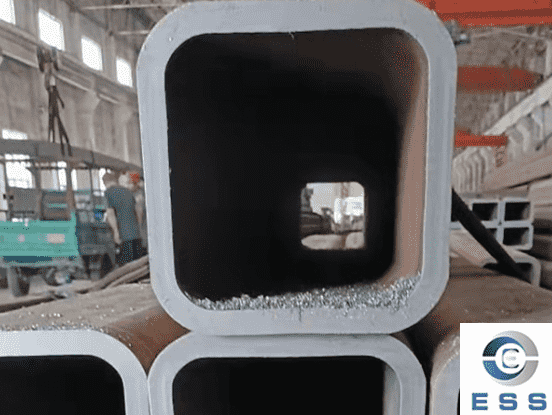It is feasible to use carbon
steel pipe for hydrogen, but attention should be paid to the permeability
of hydrogen and its corrosion to carbon steel, as well as the requirements for
pipe selection, design, manufacturing and installation.

Characteristics of hydrogen and its
requirements for pipes
Hydrogen is a colorless and odorless gas
with a density lower than that of air, and has strong permeability and
diffusivity. During transportation, hydrogen can easily penetrate through tiny
gaps and defects in the pipe, causing safety hazards. Therefore, for hydrogen
transportation pipes, excellent sealing and anti-permeation properties are
required.
In addition, hydrogen has a certain degree
of corrosiveness to metals, especially under high temperature and high pressure
conditions, which may cause corrosion and damage to the pipe. Therefore, the
selection of pipes also needs to consider their corrosion resistance.
Material characteristics of carbon steel
pipes
Carbon steel pipes are a commonly used
metal pipe, including seamless
steel pipe and welded
steel pipe, with excellent mechanical properties and processing properties.
In hydrogen transportation, carbon steel pipes can meet the needs of hydrogen
transportation through reasonable material selection, design, manufacturing and
installation measures.
However, it should be noted that the
corrosion problem of carbon steel pipes in hydrogen environments cannot be
ignored. In order to reduce the risk of corrosion, alloy steel pipes or coated
steel pipes with better hydrogen corrosion resistance can be used.
Conditions for the use of carbon steel
pipes for transporting hydrogen
1. Pipeline material selection: Carbon
steel pipes should be seamless steel pipes, and the inner wall should be
rust-free to its original color. When welding the pipeline, carbon steel pipes
should be primed with argon arc welding to prevent welding slag, rust, etc.
from remaining in the pipeline.
2. Connection method: Hydrogen pipelines should be connected by welding, and other
connection methods are potential sources of leakage. However, the connection
with equipment and valves can be flanged or threaded, and
polytetrafluoroethylene film should be used as filler when threaded.
3. Valve selection: Ball valves and globe
valves should be used for hydrogen pipeline valves. When the working
pressure is greater than 0.1 MPa, gate valves are strictly prohibited. When
there is alkali in the electrolytic hydrogen, the valve material cannot be
copper alloy.
4. Anti-leakage measures: Hydrogen
pipelines should avoid passing through trenches, sewers, railways and roads,
etc., and casings should be installed when they should be passed through.
Hydrogen pipelines must not pass through living rooms, offices, power
distribution rooms, instrument rooms, stairwells and other rooms where hydrogen
is not used. They should not pass through suspended ceiling technical
(mezzanine) layers. Safety measures should be taken when passing through
suspended ceilings and technical (mezzanine) layers.
5. Anti-static and lightning protection
measures: To prevent lightning induction, leakage current and static
electricity accumulation, metal pipes and metal frames, cable metal casings,
and both ends of outdoor overhead hydrogen pipelines and metal pipe racks
should be grounded. Metal wires should be used to cross-connect pipe flange,
valves and other connections.
6. Environmental adaptability: Hydrogen
pipelines should avoid passing through rooms where hydrogen is used. Cut-off
valves should be installed at hydrogen entering workshops and branches of
hydrogen equipment. Hydrogen equipment with open flames should also be equipped
with flame arresters.
7. Safety inspection: When checking for
leaks at connection points such as hydrogen equipment, pipelines and valves,
neutral soapy water or a portable combustible gas detection alarm should be
used. It is forbidden to use open flames for leak inspection.
In practical applications, it is also
necessary to select appropriate pipe specifications and types based on the
hydrogen delivery volume, pressure, temperature and other parameters. At the
same time, the quality of the pipe manufacturing and installation process must
also be strictly controlled to ensure the integrity and reliability of the
pipe.
Summary
In summary, it is feasible to use carbon
steel pipes for hydrogen, but attention should be paid to issues such as
hydrogen permeability and corrosion to carbon steel. In practical applications,
appropriate pipe types, specifications and manufacturing and installation
methods should be selected according to the characteristics and transportation
requirements of hydrogen to ensure the safety and reliability of hydrogen
transportation. At the same time, with the continuous development of technology
and the emergence of new materials, the choice of hydrogen transportation pipes
will be more abundant and diversified in the future. For specific hydrogen
transportation projects, detailed evaluation and testing should be carried out
in combination with actual conditions to ensure the rationality and
effectiveness of pipe selection. In addition, sufficient attention should be
paid to the maintenance and inspection of the hydrogen transportation system to
promptly discover and deal with potential safety hazards and ensure the
long-term stable operation of hydrogen transportation.













 Eastern Steel Manufacturing Co.,Ltd not only improve product production and sales services, but also provide additional value-added services. As long as you need, we can complete your specific needs together.
Eastern Steel Manufacturing Co.,Ltd not only improve product production and sales services, but also provide additional value-added services. As long as you need, we can complete your specific needs together.










